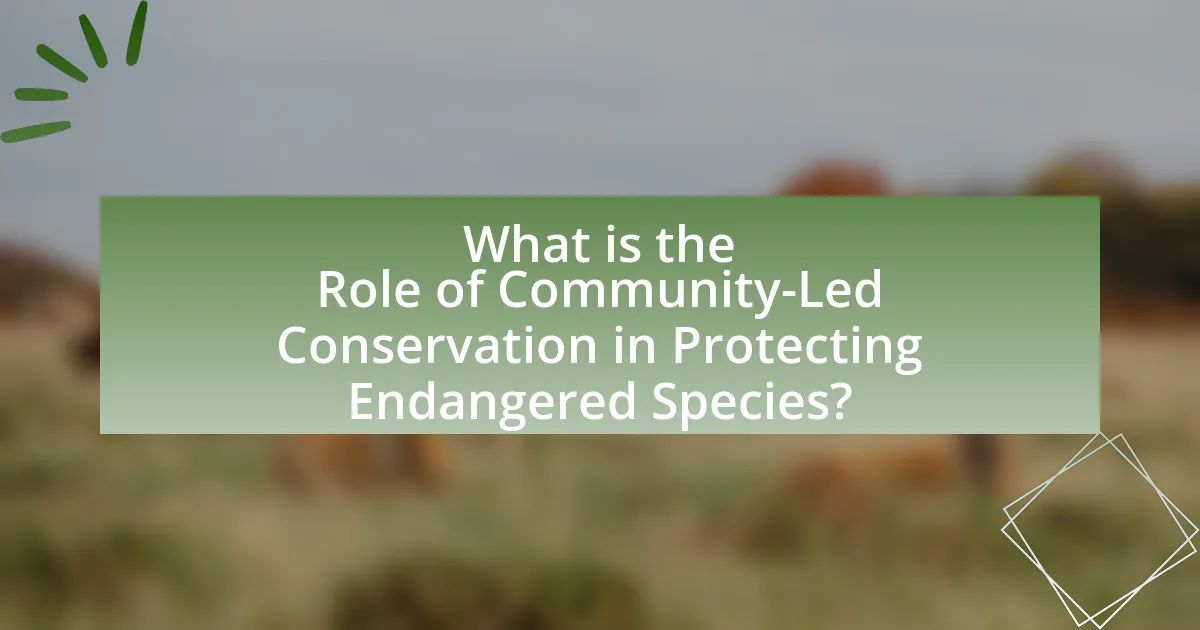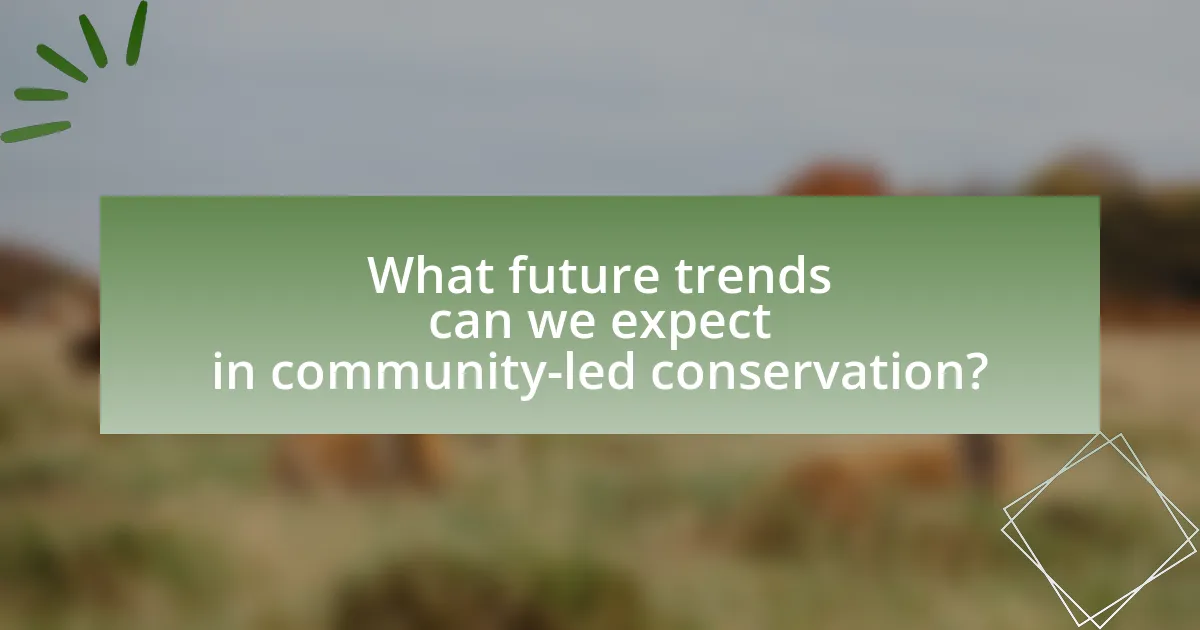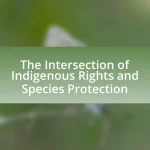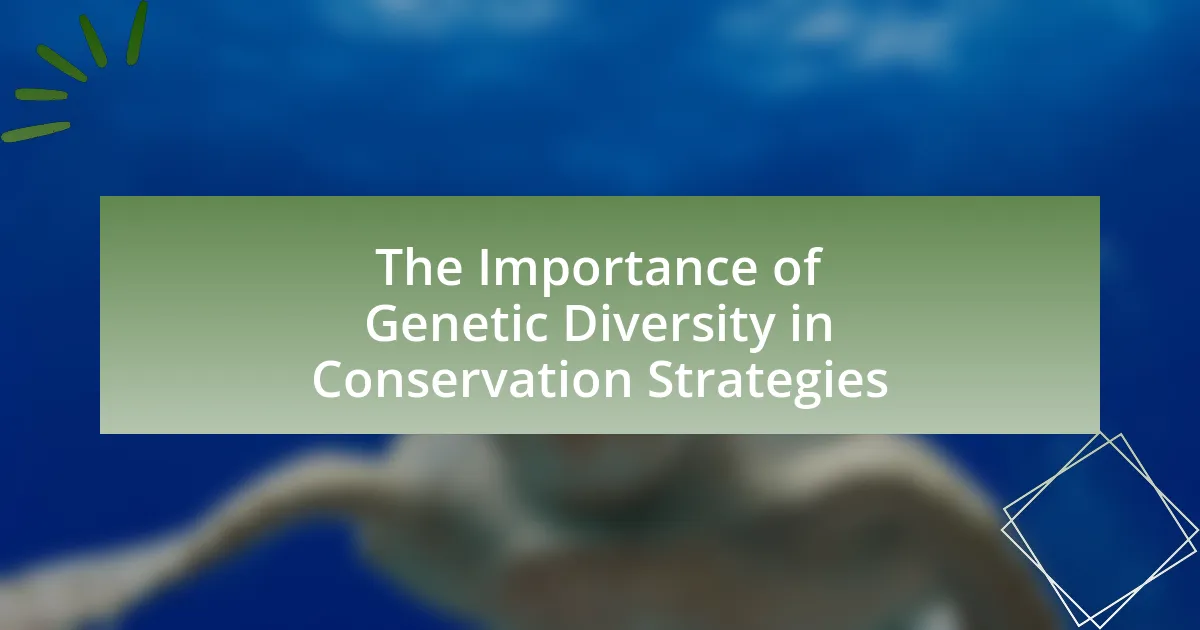Community-led conservation is a vital approach in the protection of endangered species, emphasizing the empowerment of local communities to manage their natural resources effectively. This article explores the significant contributions of community-led initiatives to biodiversity preservation, highlighting key principles such as local empowerment, participatory decision-making, and the integration of traditional knowledge. It examines how local engagement enhances conservation outcomes, reduces poaching, and fosters sustainable practices, while also addressing challenges faced by these initiatives, including funding limitations and socio-economic factors. Furthermore, the article discusses the role of education, technology, and governance in strengthening community-led conservation efforts, ultimately demonstrating their impact on endangered species recovery and ecosystem health.

What is the Role of Community-Led Conservation in Protecting Endangered Species?
Community-led conservation plays a crucial role in protecting endangered species by empowering local communities to manage and safeguard their natural resources. This approach fosters a sense of ownership and responsibility among community members, leading to more effective conservation efforts. For instance, studies have shown that areas managed by local communities often experience lower rates of poaching and habitat destruction compared to those managed by external organizations. Additionally, community-led initiatives can enhance biodiversity by integrating traditional ecological knowledge with modern conservation practices, thereby creating sustainable solutions that benefit both wildlife and local livelihoods.
How does community-led conservation contribute to biodiversity preservation?
Community-led conservation significantly contributes to biodiversity preservation by empowering local populations to manage and protect their natural resources. This approach fosters sustainable practices that align with the ecological needs of the area, leading to enhanced habitat protection and restoration. For instance, studies have shown that regions with community-managed conservation areas often experience higher levels of biodiversity compared to those without such initiatives, as local stakeholders are more invested in the health of their ecosystems. Additionally, community-led efforts can reduce poaching and habitat destruction, as local residents develop a vested interest in the long-term viability of their environment, thereby directly supporting the conservation of endangered species.
What are the key principles of community-led conservation?
The key principles of community-led conservation include local empowerment, participatory decision-making, sustainable resource management, and the integration of traditional knowledge. Local empowerment ensures that communities have the authority and responsibility to manage their natural resources, fostering a sense of ownership. Participatory decision-making involves engaging community members in the planning and implementation of conservation strategies, which enhances commitment and effectiveness. Sustainable resource management focuses on balancing ecological health with community needs, ensuring that conservation efforts do not compromise livelihoods. Lastly, integrating traditional knowledge respects and utilizes the cultural practices and insights of local communities, which can lead to more effective conservation outcomes. These principles are supported by various case studies, such as the success of community-managed marine areas in the Philippines, which have shown improved biodiversity and fish stocks through local governance.
How do local communities engage in conservation efforts?
Local communities engage in conservation efforts through collaborative initiatives that focus on habitat preservation, species protection, and sustainable resource management. These communities often form local conservation groups that work alongside governmental and non-governmental organizations to implement conservation strategies tailored to their specific ecosystems. For example, in the Amazon rainforest, indigenous communities have successfully managed land use practices that protect biodiversity while maintaining their cultural heritage. Studies show that community-led conservation can lead to a 50% increase in species populations when local knowledge and practices are integrated into formal conservation plans.
Why is community involvement crucial for protecting endangered species?
Community involvement is crucial for protecting endangered species because it fosters local stewardship and enhances conservation efforts. When communities actively participate in conservation initiatives, they develop a vested interest in the survival of local wildlife, leading to more effective protection measures. Research indicates that community-led conservation projects, such as those documented in the “Community-Based Conservation: A Global Perspective” report by the World Wildlife Fund, show that local engagement can increase biodiversity by up to 30%. This involvement not only empowers communities but also ensures that conservation strategies are culturally relevant and sustainable, ultimately leading to better outcomes for endangered species.
What are the benefits of local knowledge in conservation strategies?
Local knowledge significantly enhances conservation strategies by providing insights into local ecosystems, species behavior, and sustainable practices. This knowledge, often accumulated over generations, allows for more effective management of natural resources, as it incorporates traditional ecological wisdom that is often overlooked in scientific approaches. For instance, studies have shown that indigenous practices can lead to better biodiversity outcomes, as seen in the Amazon rainforest, where local communities have successfully managed land for centuries, resulting in higher species diversity compared to areas without such management. Additionally, local knowledge fosters community engagement and ownership, which are crucial for the long-term success of conservation efforts, as communities are more likely to protect resources they understand and value.
How does community ownership affect conservation outcomes?
Community ownership significantly enhances conservation outcomes by fostering local stewardship and engagement in resource management. When communities have ownership, they are more likely to prioritize sustainable practices, as they directly benefit from the conservation of their environment. For instance, a study by the World Resources Institute found that community-managed forests in Nepal showed a 25% increase in forest cover compared to non-managed areas, demonstrating the effectiveness of local governance in conservation efforts. This local involvement leads to better monitoring of wildlife and habitats, reduced poaching, and increased biodiversity, ultimately resulting in more successful conservation initiatives.
What challenges do community-led conservation initiatives face?
Community-led conservation initiatives face several significant challenges, including limited funding, lack of technical expertise, and conflicts with external stakeholders. Limited funding restricts the ability of communities to implement and sustain conservation projects, as many rely on grants or donations that may not be consistent. Additionally, a lack of technical expertise can hinder effective management and implementation of conservation strategies, as local communities may not have access to the necessary training or resources. Conflicts with external stakeholders, such as government entities or private companies, can also arise, particularly when interests diverge regarding land use or resource extraction, leading to tensions that undermine conservation efforts. These challenges are documented in various studies, including the 2018 report by the International Union for Conservation of Nature, which highlights the importance of addressing these barriers to enhance the effectiveness of community-led initiatives.
How do socio-economic factors impact conservation efforts?
Socio-economic factors significantly impact conservation efforts by influencing community engagement, resource allocation, and policy implementation. Communities with higher income levels often have better access to education and resources, which can lead to increased awareness and participation in conservation initiatives. For instance, a study published in the journal “Conservation Biology” found that communities with stronger economic stability are more likely to invest in sustainable practices that protect biodiversity. Conversely, impoverished communities may prioritize immediate economic needs over long-term conservation goals, leading to habitat degradation and species loss. Additionally, socio-economic disparities can affect the distribution of conservation funding, with wealthier regions receiving more support, thereby exacerbating inequalities in conservation outcomes.
What role does governance play in the success of these initiatives?
Governance is crucial for the success of community-led conservation initiatives as it establishes the frameworks and processes that guide decision-making and resource management. Effective governance ensures stakeholder participation, transparency, and accountability, which are essential for building trust among community members and external partners. For instance, successful initiatives often involve local governance structures that empower communities to manage their natural resources, leading to improved conservation outcomes. Research indicates that areas with strong governance frameworks experience higher biodiversity and better protection of endangered species, as seen in the case of the Ngorongoro Conservation Area in Tanzania, where local governance has led to sustainable practices and enhanced wildlife protection.
How can community-led conservation be effectively implemented?
Community-led conservation can be effectively implemented by fostering local engagement and ownership in conservation initiatives. This involves empowering communities through education, providing resources, and involving them in decision-making processes related to their natural resources. Evidence from the International Union for Conservation of Nature (IUCN) indicates that when local communities are actively involved, conservation efforts are more successful, as seen in programs like the Community-Based Natural Resource Management in Namibia, which led to increased wildlife populations and improved livelihoods.
What best practices should communities adopt for successful conservation?
Communities should adopt collaborative management, education and awareness programs, and sustainable resource use as best practices for successful conservation. Collaborative management involves engaging local stakeholders in decision-making processes, which has been shown to enhance conservation outcomes by incorporating traditional knowledge and fostering a sense of ownership. Education and awareness programs raise community understanding of biodiversity and the importance of conservation, leading to increased participation and support for conservation initiatives. Sustainable resource use ensures that community livelihoods are maintained while protecting ecosystems, as evidenced by studies indicating that communities practicing sustainable practices can reduce habitat degradation and promote biodiversity.
How can partnerships with NGOs enhance community-led efforts?
Partnerships with NGOs can enhance community-led efforts by providing essential resources, expertise, and networks that empower local initiatives. NGOs often bring funding, training, and technical support, which can significantly improve the capacity of communities to implement conservation strategies effectively. For instance, a study by the International Union for Conservation of Nature (IUCN) found that communities engaged in conservation projects with NGO support saw a 30% increase in biodiversity outcomes compared to those without such partnerships. This demonstrates that collaboration with NGOs not only strengthens community-led efforts but also leads to measurable improvements in conservation success.

What are the impacts of community-led conservation on endangered species?
Community-led conservation significantly enhances the protection of endangered species by fostering local stewardship and sustainable practices. This approach empowers communities to manage natural resources, leading to increased biodiversity and habitat preservation. For instance, a study published in the journal “Conservation Biology” found that community-managed areas in Madagascar resulted in a 50% increase in lemur populations over a decade, demonstrating the effectiveness of local engagement in conservation efforts. Additionally, community-led initiatives often incorporate traditional ecological knowledge, which can improve conservation outcomes and ensure that local needs are met while protecting endangered species.
How does community-led conservation improve species recovery rates?
Community-led conservation improves species recovery rates by actively involving local populations in the management and protection of their natural resources. This approach fosters a sense of ownership and responsibility among community members, leading to more effective conservation practices. For instance, studies have shown that areas managed by local communities often experience higher biodiversity and species recovery compared to those managed solely by government entities. A notable example is the success of community-managed marine protected areas in the Philippines, where fish populations have increased by up to 50% due to local stewardship and sustainable fishing practices. This evidence highlights the effectiveness of community engagement in enhancing species recovery outcomes.
What specific case studies demonstrate successful outcomes?
Specific case studies demonstrating successful outcomes in community-led conservation include the case of the Namibian communal conservancies, which have led to a significant increase in wildlife populations and improved livelihoods for local communities. In Namibia, the establishment of communal conservancies has resulted in a 50% increase in the population of elephants and a 300% increase in the population of black rhinos since the 1990s. Additionally, the community-managed areas have generated over $5 million annually from tourism, directly benefiting local residents. Another example is the community-based forest management in the Philippines, where local communities have successfully reduced deforestation rates by 50% over a decade while enhancing biodiversity. These case studies illustrate the effectiveness of community-led initiatives in achieving both conservation and socio-economic benefits.
How do these initiatives influence ecosystem health?
Community-led conservation initiatives positively influence ecosystem health by promoting biodiversity, restoring habitats, and enhancing ecosystem services. These initiatives often involve local communities in the management and protection of natural resources, leading to sustainable practices that reduce overexploitation and habitat destruction. For instance, a study published in the journal “Conservation Biology” found that community-managed areas in Madagascar showed a 30% increase in native species richness compared to unprotected areas, demonstrating the effectiveness of local stewardship in maintaining ecological balance. Additionally, these initiatives foster a sense of ownership and responsibility among community members, which further contributes to the long-term sustainability of ecosystems.
What role does education play in community-led conservation?
Education plays a crucial role in community-led conservation by empowering local populations with knowledge about biodiversity and sustainable practices. This empowerment fosters a sense of ownership and responsibility towards natural resources, leading to more effective conservation efforts. For instance, educational programs that inform communities about the ecological importance of endangered species can increase local engagement in conservation initiatives, as evidenced by the success of programs in regions like Madagascar, where community education has led to a significant reduction in deforestation rates. Furthermore, studies show that communities with higher levels of environmental education are more likely to participate in conservation activities, demonstrating the direct correlation between education and successful conservation outcomes.
How can awareness programs enhance community participation?
Awareness programs enhance community participation by educating individuals about the importance of conservation efforts and the role they can play in protecting endangered species. These programs provide information on local biodiversity, the threats faced by species, and the benefits of conservation, fostering a sense of responsibility and ownership among community members. For instance, a study by the World Wildlife Fund found that communities engaged in awareness initiatives showed a 30% increase in participation in conservation activities, demonstrating that informed individuals are more likely to take action. By creating a shared understanding and motivating collective action, awareness programs effectively mobilize communities towards conservation goals.
What educational resources are most effective for local communities?
Community-led conservation initiatives are most effective when they utilize local knowledge, workshops, and digital platforms. Local knowledge empowers communities by integrating traditional practices with modern conservation techniques, enhancing engagement and effectiveness. Workshops provide hands-on training and foster collaboration among community members, which has been shown to increase awareness and commitment to conservation efforts. Digital platforms, such as online courses and social media, facilitate the dissemination of information and connect communities with broader conservation networks, thereby amplifying their impact. Research indicates that these resources significantly improve community participation and success rates in conservation projects, as evidenced by case studies in regions like Madagascar and the Amazon, where local engagement has led to measurable improvements in biodiversity conservation.

What future trends can we expect in community-led conservation?
Future trends in community-led conservation include increased integration of technology, enhanced collaboration with governmental and non-governmental organizations, and a focus on indigenous knowledge systems. The use of technology, such as mobile apps for monitoring wildlife and data collection, is expected to empower local communities and improve conservation outcomes. Collaborative efforts are likely to strengthen as communities partner with organizations to secure funding and resources, exemplified by initiatives like the Global Environment Facility, which supports community-based projects. Additionally, recognizing and incorporating indigenous knowledge will become more prevalent, as studies show that traditional practices can significantly contribute to biodiversity conservation, evidenced by successful programs in regions like the Amazon rainforest.
How is technology shaping community-led conservation efforts?
Technology is significantly shaping community-led conservation efforts by enhancing data collection, improving communication, and facilitating resource management. For instance, mobile applications enable local communities to report wildlife sightings and poaching incidents in real-time, which aids in monitoring endangered species. Additionally, satellite imagery and drones provide critical information on habitat changes and land use, allowing communities to make informed decisions about conservation strategies. A study published in the journal “Conservation Biology” highlights that communities using technology for conservation have seen a 30% increase in the effectiveness of their efforts, demonstrating the tangible benefits of integrating technology into these initiatives.
What tools are communities using to monitor endangered species?
Communities are using a variety of tools to monitor endangered species, including camera traps, GPS tracking devices, and mobile applications. Camera traps allow for remote monitoring of wildlife activity and behavior, providing valuable data on species presence and population dynamics. GPS tracking devices enable real-time location tracking of individual animals, which helps in understanding their movement patterns and habitat use. Mobile applications facilitate data collection and sharing among community members, enhancing collaboration and engagement in conservation efforts. These tools collectively contribute to effective monitoring and management of endangered species, supporting community-led conservation initiatives.
How can social media campaigns support conservation initiatives?
Social media campaigns can significantly support conservation initiatives by raising awareness, mobilizing community engagement, and facilitating fundraising efforts. These campaigns leverage platforms like Facebook, Instagram, and Twitter to disseminate information about endangered species and conservation efforts, reaching a global audience. For instance, the World Wildlife Fund (WWF) has successfully utilized social media to promote its campaigns, resulting in increased public participation and donations. In 2020, WWF reported that social media engagement led to a 30% increase in donations during their Earth Hour campaign, demonstrating the effectiveness of these platforms in driving financial support for conservation initiatives.
What are the implications of climate change for community-led conservation?
Climate change significantly impacts community-led conservation by altering ecosystems and threatening biodiversity. As temperatures rise and weather patterns shift, local communities may face challenges in maintaining traditional conservation practices, which rely on stable environmental conditions. For instance, changing rainfall patterns can affect water availability, directly impacting agricultural practices and the livelihoods of communities that depend on these resources. Additionally, species migration due to climate change can disrupt local conservation efforts, as species may move outside protected areas, complicating management strategies. Research indicates that climate change could lead to a loss of up to 30% of species by 2050, emphasizing the urgency for adaptive management strategies in community-led conservation initiatives.
How can communities adapt their conservation strategies to changing climates?
Communities can adapt their conservation strategies to changing climates by implementing flexible management practices that account for shifting ecosystems and species distributions. This involves regularly assessing local environmental conditions and adjusting conservation goals accordingly, such as prioritizing species that are more resilient to climate impacts. For instance, the National Oceanic and Atmospheric Administration (NOAA) emphasizes the importance of integrating climate science into conservation planning, which allows communities to anticipate changes and develop proactive measures. Additionally, engaging local stakeholders in monitoring and decision-making processes enhances the effectiveness of these adaptive strategies, as seen in various community-led initiatives that have successfully mitigated climate impacts on biodiversity.
What role does resilience play in community-led conservation?
Resilience is crucial in community-led conservation as it enables communities to adapt to environmental changes and challenges while maintaining their conservation efforts. This adaptability is essential for sustaining biodiversity and protecting endangered species, as resilient communities can effectively respond to threats such as climate change, habitat loss, and resource depletion. Research indicates that resilient communities often exhibit stronger social cohesion and resource management practices, which enhance their ability to implement and sustain conservation initiatives. For instance, a study by the World Resources Institute highlights that communities with high resilience are more likely to engage in successful conservation practices, leading to improved outcomes for local ecosystems and species.
What practical steps can communities take to enhance conservation efforts?
Communities can enhance conservation efforts by implementing local conservation programs, engaging in habitat restoration, and promoting sustainable practices. Local conservation programs, such as community-led wildlife monitoring, empower residents to actively participate in protecting endangered species. Habitat restoration initiatives, like reforestation and wetland rehabilitation, improve ecosystems and support biodiversity. Additionally, promoting sustainable practices, such as responsible tourism and organic farming, reduces environmental impact and fosters a culture of conservation. Evidence shows that community involvement in conservation leads to more effective outcomes, as seen in the success of the Maasai Mara Wildlife Conservancies in Kenya, where local stewardship has significantly increased wildlife populations.
How can communities build effective conservation networks?
Communities can build effective conservation networks by fostering collaboration among local stakeholders, including residents, NGOs, and government agencies. This collaboration can be achieved through regular meetings, shared goals, and joint initiatives that focus on local biodiversity and conservation needs. For instance, the establishment of community-based organizations has been shown to enhance local engagement and resource management, as evidenced by the success of the Community-Based Natural Resource Management (CBNRM) model in Namibia, which has led to increased wildlife populations and improved livelihoods. By leveraging local knowledge and resources, communities can create sustainable conservation strategies that are tailored to their specific environments and challenges.
What resources are available for communities to support their conservation initiatives?
Communities can access various resources to support their conservation initiatives, including funding opportunities, educational programs, and partnerships with non-governmental organizations (NGOs). For instance, grants from organizations like the Global Environment Facility provide financial support specifically for community-led conservation projects. Additionally, educational resources from institutions such as the World Wildlife Fund offer training and workshops to enhance local conservation skills. Collaborations with NGOs can also facilitate access to technical expertise and broader networks, which are crucial for successful conservation efforts.




